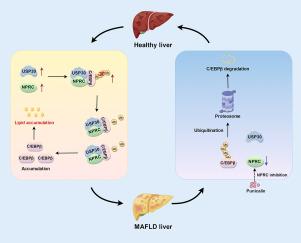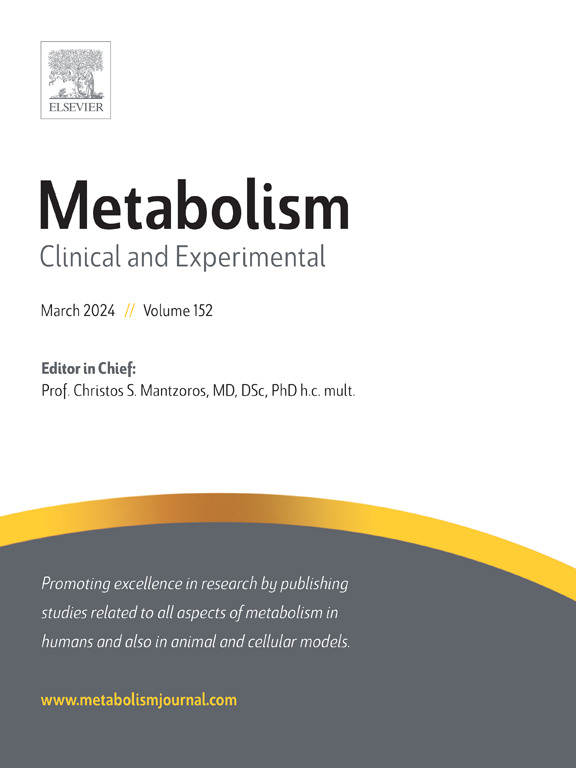NPRC 通过 USP30 介导的 C/EBPβ 去泛素化促进肝脏脂肪变性。
IF 10.8
1区 医学
Q1 ENDOCRINOLOGY & METABOLISM
引用次数: 0
摘要
背景和目的:代谢功能障碍相关性脂肪肝(MAFLD)是一种普遍存在的慢性肝病,其特点是脂质代谢紊乱。钠尿肽受体 C(Natriuretic Peptide Receptor C,NPRC)是一种负责清除钠尿肽的受体,它在 MAFLD 中的作用仍然难以捉摸。因此,本研究旨在阐明 NPRC 在 MAFLD 进展中的作用:本研究表明,NPRC可促进脂质代谢重编程并加速MAFLD的进展。包括蛋白质组学和泛素化分析在内的机理研究表明,NPRC水平升高会稳定C/EBPβ蛋白,从而导致脂质过度积累。C/EBPβ的DNA结合域(DBD)与去泛素化酶USP30相互作用,后者是抑制C/EBPβ的K149特异性K48连锁多泛素化的关键调节因子。重要的是,NPRC 的 ANPR 区域与 USP30 结合,促进了 C/EBPβ 的去泛素化。此外,通过虚拟筛选发现,天然化合物 punicalin 是一种潜在的 NPRC 表达抑制剂,可减少肝脏脂质积累、炎症和纤维化:我们的研究结果表明,NPRC会招募USP30来介导C/EBPβ的去泛素化,从而推动脂质代谢的重编程。以 NPRC 为靶点可能是治疗 MAFLD 的一种有前景的方法。本文章由计算机程序翻译,如有差异,请以英文原文为准。

NPRC promotes hepatic steatosis via USP30-mediated deubiquitination of C/EBPβ
Background and aims
Metabolic dysfunction-associated fatty liver disease (MAFLD) is a prevalent chronic liver condition characterised by dysregulated lipid metabolism. The role of Natriuretic Peptide Receptor C (NPRC), a receptor responsible for clearing natriuretic peptides, in MAFLD remains elusive. Therefore, the aim of the present study was to elucidate the role of NPRC in MAFLD progression.
Approach and results
This study demonstrated that NPRC enhanced lipid metabolism reprogramming and accelerated MAFLD progression. Mechanistic investigations, including proteomic and ubiquitination analyses, revealed that elevated NPRC levels stabilized the C/EBPβ protein, leading to excessive lipid accumulation. The DNA-binding domain (DBD) of C/EBPβ interacted with the deubiquitinase USP30, a key regulator that inhibited K149-specific K48-linked polyubiquitination of C/EBPβ. Importantly, the ANPR region of NPRC bound to USP30, facilitating the deubiquitination of C/EBPβ. Furthermore, virtual screening identified punicalin, a natural compound, as a potential inhibitor of NPRC expression, which may reduce hepatic lipid accumulation, inflammation and fibrosis.
Conclusions
Our findings indicate that NPRC recruits USP30 to mediate the deubiquitination of C/EBPβ, driving lipid metabolism reprogramming. Targeting NPRC could represent a promising therapeutic approach for MAFLD.
求助全文
通过发布文献求助,成功后即可免费获取论文全文。
去求助
来源期刊

Metabolism: clinical and experimental
医学-内分泌学与代谢
CiteScore
18.90
自引率
3.10%
发文量
310
审稿时长
16 days
期刊介绍:
Metabolism upholds research excellence by disseminating high-quality original research, reviews, editorials, and commentaries covering all facets of human metabolism.
Consideration for publication in Metabolism extends to studies in humans, animal, and cellular models, with a particular emphasis on work demonstrating strong translational potential.
The journal addresses a range of topics, including:
- Energy Expenditure and Obesity
- Metabolic Syndrome, Prediabetes, and Diabetes
- Nutrition, Exercise, and the Environment
- Genetics and Genomics, Proteomics, and Metabolomics
- Carbohydrate, Lipid, and Protein Metabolism
- Endocrinology and Hypertension
- Mineral and Bone Metabolism
- Cardiovascular Diseases and Malignancies
- Inflammation in metabolism and immunometabolism
 求助内容:
求助内容: 应助结果提醒方式:
应助结果提醒方式:


